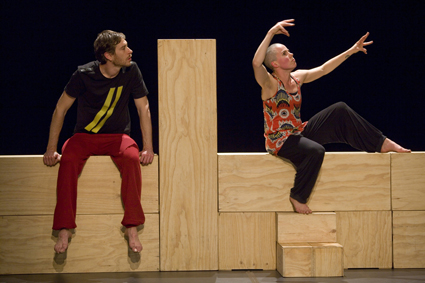 |
Lee Serle, Kirstie McCracken, Double Think, Force Majeure photo Ponch Hawkes |
Perhaps there is a fourth star: the lighting which dulls, darts, smashes and gleams its way through and across this performance, establishing atmospheres and episodes as clearly as the shape of the wall and the tone of the choreography.
The opening sequence is an assault. Sharp lights, sometimes controlled by the performers, are aimed directly at me, flashing on and off to a noisy, rhythmic grind, leaving smears and traces across my retinas, as snaps of the dismantling wall leave me grieving for its unity. The virtual traces of burnt light create shapes floating in the dense black nothingness where I know there is something; white to black, dark to light, something to nothing, full to empty, seen and unseen.
After the final snap, the light bleeds into a dully lit McCracken solo while Serle, thankfully, re-assembles the wall. This solo is full of paddled hands and lengthened arms atop turned out hips generating circular changes in direction on legs that bend and straighten, travelling and propping. A contemporary dance solo.
But the next dance makes the dance of the wall simply surprising. Blocks smoothly protrude and recede, blocking light, contorting geometrics and making shadows that swing back and forth darkly across the wooden skin. This relation of ephemerality and solidity embodies choreographer Byron Perry’s central notion of the “illusion of opposition.” Two apparently antithetical states or substances exist not in actual opposition but in the continuum of flux. While Perry’s program notes focus on the “imperfect sense” of a tall man (Serle) and a relatively short woman (McCracken) dueting, it is also found in the very substance of the timber tetrus: solid yet flexible, impenetrable and open, coherent and devolving, reflective and dense, dead and alive.
After the wall stops dancing, the tall man and the short woman emerge through gaps, like cockroaches. In a sequence where only the upper bodies are visible, lovely little rhythmic phrases disappear in the onward thrust of choreography that rushes toward crescendo. Quirky, intricate, slippery unison that slips into canon is broken by one luscious moment where she strokes the wood, the contact of two skins. At this moment the choreography hushes in a brief adoration. They scuttle back into darkness.
Later, the dancers are dimly framed by the re-arranged wall, separated but the same. They have become distant dreams in individual pools of soft light that fades them into oblivion, only to bring them back again in a slow, imperceptible sweep. Their quickly moving flesh becomes swipes of action in near-blackness, almost unreal, yet heightening their aliveness through the silky texture of skin. Created at a distance these dancers become chimeras, ghosts, cartoons, virtual realities, fading photographs and dying swans.
Force Majeure, Gogglebox and Double Think, director, choreographer Byron Perry, performers Kirstie McCracken, Lee Serle, set construction Ben Cobham/Bluebottle, lighting Benjamin Cisterne, sound composition Luke Smiles, costumes Natasha Fagg; The Reginald, Seymour Centre, Sydney, 21-24 Aug
RealTime issue #117 Oct-Nov 2013 pg. 20
© Pauline Manley; for permission to reproduce apply to [email protected]








 back
back